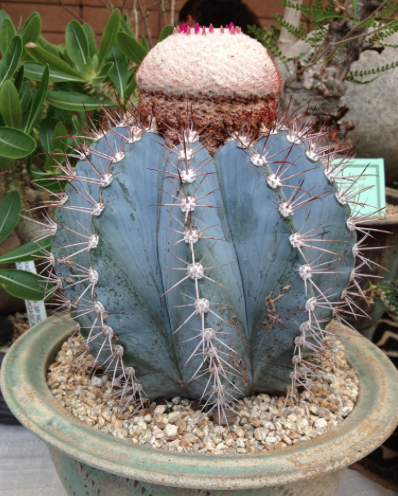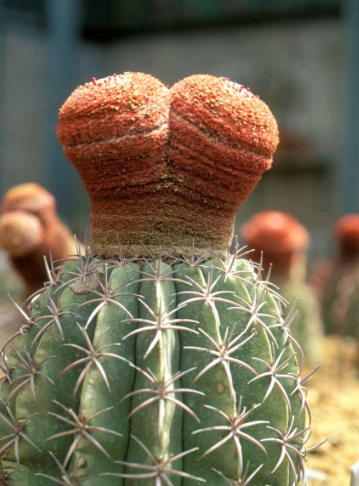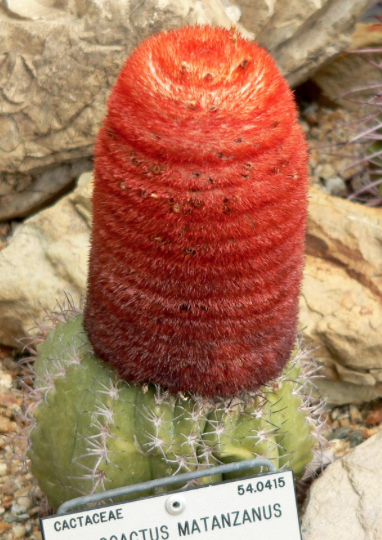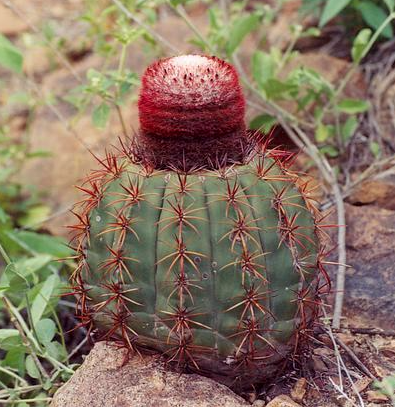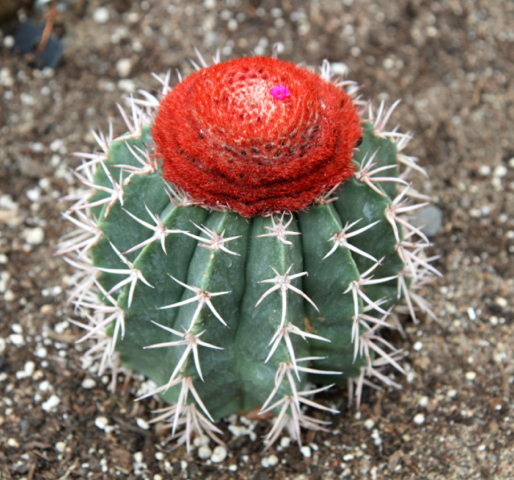Submitted by: Jim Tanner
Melocactus are immediately recognizable by the large cephalium that develops on mature plants. Melocactus grow as normal appearing, but flowerless, globular cacti until they reach maturity. This can take from 6 to 15 years in cultivation, with a greater range in habitat. Once they reach maturity, the body stops growing vigorously (it still grows slowly). Most of the plant energy goes into producing a cylindrical flowering and fruiting structure known as a cephalium. This is usually white, with short hairs of yellow, orange or red. As the years go by, the cephalium becomes more cylindrical, with the base becoming more colorful The flowers are usually a red-purple, and the fruits are almost always a bright red, to attract birds. With age, the cephalium can grow to 18 inches or more in height.
Melocactus are native to a large region, Brazil to Southern Mexico, including a good part of the Caribbean. As might be expected, cacti from the tropical regions, particularly coastal regions are sensitive to cold and wet. Cold and wet conditions can cause scarring of the body, which usually appears as brown or tan lesions on the skin. A few of these are unavoidable, but a badly scarred plant quickly becomes unsightly. At the same time, almost all of the Melocactus expect high humidity and a higher moisture level than might be expected. Many grow within sight of the ocean, or in some of the more tropical and humid regions of Brazil. They like water, but demand good drainage.
Melocactus are generally solitary, so the only means of propagation is through seeds. Fortunately they produce plenty of seed, and these germinate readily, particularly when the weather is warm. Keep the seedlings protected from direct sun, and moist until fairly large. It takes several years from seed to a flowering plant.
[Ed: The following is the abstract from an interesting article in Biotropica Vol. 26, No. 3 (Sep., 1994), pp. 295-301. Where “Saurocory” means seed dispersal. According to the article, to successfully propagate M. violaceus from seed we need to keep lizards, and follow them about hoping for seeds.]
Saurocory in Melocactus violaceus (Cactaceae)
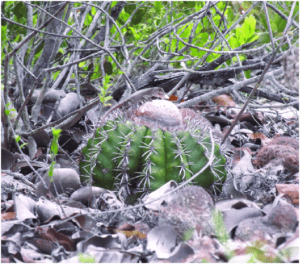
The button cactus, Melocactus violaceus (Cactaceae), occurs in open, sandy soils in southern Brazilian coastal areas. The fruits of this species are pink, cone-shaped, and have a high water content and low sugar concentration. The fruits of M. violaceus develop while completely protected inside the cephalium and are driven out by internal pressure when ripe. Fruits can be exposed in only a few minutes during the hottest part of the day, and they become easily visible over the cephalium. They are expelled more quickly when temperature is high and lizards are more active. During the dry season these fruits appear to be eaten exclusively by the lizard Tropidurus torquatus (Tropiduridae). The cephalium is positioned close to soil level and the bright color of the fruits apparently improves fruit detection. Lizards defecate viable M. violaceus seeds. These seeds germinated quickly under laboratory conditions, while seeds collected directly from ripe fruits did not germinate under the same conditions. Cactus and fruit morphology, and the diurnal pattern of fruit release, may represent a suite of adaptations for dispersal by Tropidurus torquatus.
LATIN LOOKUP – Loquerisne Latine (Do you speak Latin)?
The meanings of latin plant names on this page – from http://davesgarden.com/guides/botanary/
- azureus [a-ZOOR-ee-us]
Sky blue. - intortus [in-TOR-tus]
To twist in and out; to twine. - Melocactus [mel-oh-KAK-tus]
From the Greek melo (apple-shaped melon) and cactus; refers to the shape of these cacti. - peruvianus [per-u-vee-AN-us]
Of or from Peru.
